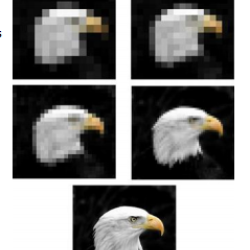Source Institutions
Source Institutions
Add to list Go to activity

This activity (page 2) draws upon a familiar, computer-based concept related to visual resolution: pixilation. The sharpness of a digital image is determined by the density of illuminated points on a screen. The smaller the points, the more that can fit into one centimeter and the greater the clarity of an image. Learners evaluate photos of varying resolution to understand how increased data density helps to create clearer patterns. This activity is a introductory lesson for a health-themed program on human biochemistry, technology, and medicine. [Activity is publicly available through a web crawler capture on Archive.org.]
- 5 to 10 minutes
- 5 to 10 minutes
- free per group of students
- Ages 11 - 14
- Activity, Lesson/Lesson Plan
- English
Quick Guide
Materials List (per group of students)
- 5 stock image photos/transparencies ranging from a low quality image (few pixels per inch) to higher quality images (more pixels per inch)
Subjects
-
Engineering and Technology
-
Computing
- Computer Science
-
Engineering
- Bioengineering/Biomedical Engineering
- Computer Engineering
-
Technology
- Medical Technology
-
Computing
-
Mathematics
-
Algebra
- Patterns
-
Data Analysis and Probability
- Data Analysis
- Representation
-
Algebra
-
The Nature of Technology
-
The Design Process
- Problem Solving
-
The Design Process
-
The Nature of Science
-
The Scientific Process
- Conducting Investigations
- Gathering Data
- Formulating Explanations
- Science as a Career
-
The Scientific Process
Informal Categories
- Computers
Audience
To use this activity, learners need to:
- see
Learning styles supported:
- Involves hands-on or lab activities
Other
Components that are part of this resource:
Includes alignment to state and/or national standards:
Access Rights:
- Free access
By:
Rights:
- All rights reserved, Arizona Science Center, 2012
Funding Source:
- Science Education Partnership Award, National Institutes of Health
